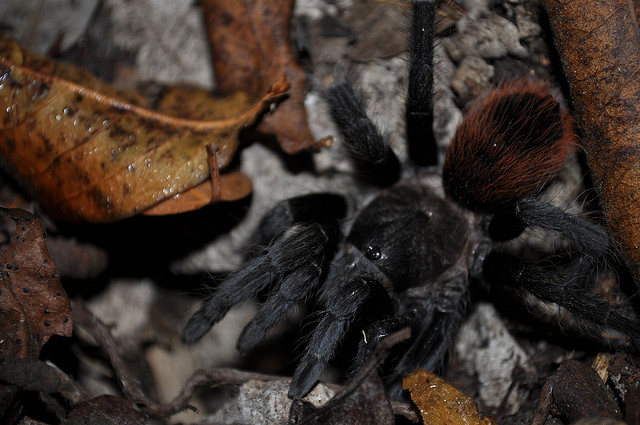Interactions
The Brachypelma vagans lives a relatively solitary,
nocternal life and hides in its burrow during the day. It
usually does not come out of the burrow unless a potential prey
victum is within striking distance. B. vagans typically
prey on insects and small vertabrates. They have a very
particular feeding technique that allows them to optimize thier
success. During the day, B. vagans will have the single
entrance burrow closed with silk, which allows them to detect
the vibrations of prospective predators and/or prey
(Vilchis-Nestor et al. 2013). This technique has proven to be
very successful for these spiders, and ultimately has improved
their fitness.
To show you exactly just how this tactic works,
click here to view a video from youtube of a B. vagans
feeding on a typical meal, a cricket! The action begins at about
45 seconds.
 B. vagans have also been known to have interactions with
two types of scorpions, Centruroides gracilis Latreille
1804 and Centruroides ochraceus Pocock 1898 (Dor and
Henaut 2011). Due to such interactions, B. vagans and these
two scorpions usually do not have any local overlap, enen though
they typically share common habitats. This interaction exerts how
successful B. vagans' predatory technique really is.
Scorpions are usually much larger and physical than tarantula's, but
the Mexican Red Rump Tarantula has proven to be a potential predator
of scorpions (Dor and Henaut 2011).
B. vagans have also been known to have interactions with
two types of scorpions, Centruroides gracilis Latreille
1804 and Centruroides ochraceus Pocock 1898 (Dor and
Henaut 2011). Due to such interactions, B. vagans and these
two scorpions usually do not have any local overlap, enen though
they typically share common habitats. This interaction exerts how
successful B. vagans' predatory technique really is.
Scorpions are usually much larger and physical than tarantula's, but
the Mexican Red Rump Tarantula has proven to be a potential predator
of scorpions (Dor and Henaut 2011).
Although similar predators may occupy the same or similar niches and habitats, they do not seem to prey on the B. vagans, or at least not very successfully. This could be due to the nocternal hunting strategy that it posesses, or the chemical defense system it obtains with it's fangs and urtication hairs. Either way, B. vagans has thrived in certain habitats, regardless of the potentially dangerous interactions it may have with organisms similar to itself.
Other than predatory interactions, B vagans interact with their opposing mate and with their spiderlings during the reproduction season. More information regarding the mating interactions can be found on the Reproduction page.